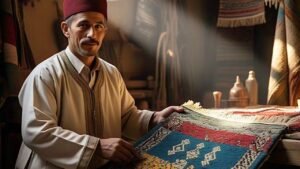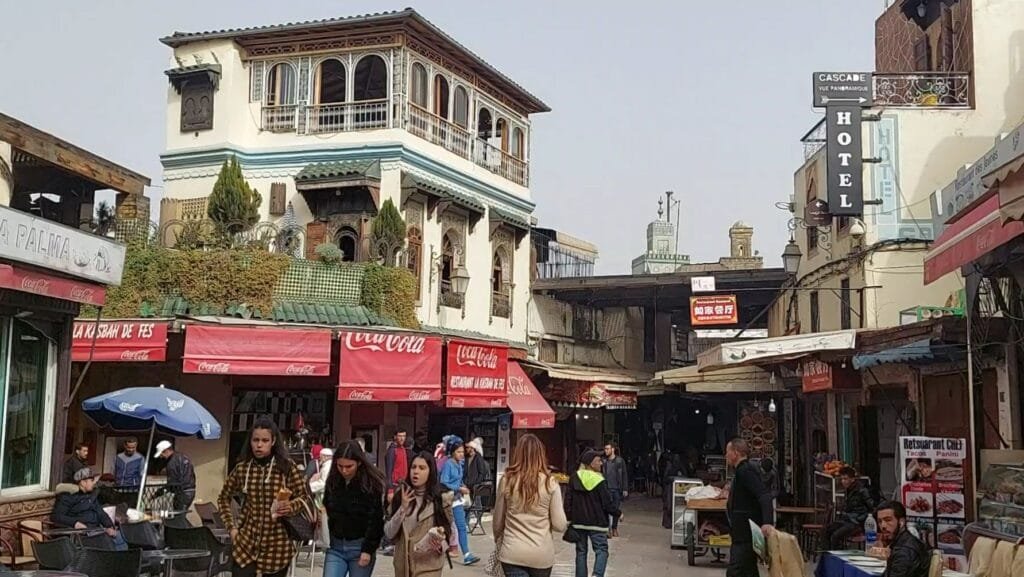
Walking through the winding alleys of the old medina, you find yourself transported into a vibrant world of handicrafts in Fez, where history and artistry intertwine seamlessly. The air hums with the rhythmic sound of tools shaping raw materials into intricate designs, while the rich scents of leather and cedarwood fill your senses. Every corner reveals a story waiting to be uncovered—a story told through the hands of master artisans preserving traditions passed down for centuries.
Chouara Tannery: A Palette of Tradition
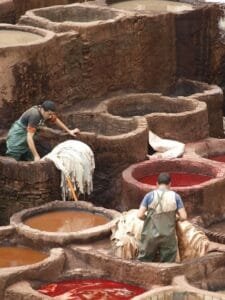
Perched on the terraces overlooking the iconic Chouara Tannery, you are greeted with a vivid tableau of circular vats filled with brilliant dyes—crimson red, saffron yellow, and deep indigo. The scene below is a living testament to the centuries-old tradition of leather tanning, a craft that remains a cornerstone of handicrafts in Fez. For over a millennium, artisans here have meticulously transformed raw hides into luxurious leather goods using natural methods and unwavering dedication.
The process itself is an art form. Men, hardened by years of experience, immerse themselves in this demanding craft, carefully soaking and dyeing hides using ingredients like pigeon droppings, lime, and vibrant pigments derived from plants and minerals. “Every color you see carries a piece of Fez’s identity,” explains Hassan, a third-generation tanner. “The red speaks of our poppy fields, the yellow of our golden sands, and the blue of our skies.” These hues, steeped in cultural symbolism, reflect the essence of Fez itself, intertwining heritage with artistry.
As you descend to explore the surrounding leather shops, the air becomes rich with the aroma of craftsmanship. Shelves brimming with handcrafted bags, jackets, and wallets beckon you to take home a piece of Fez’s legacy. These leather goods, each exuding unique character, are more than products—they are tangible connections to the medina’s rich artisanal soul.
Seffarine Square: The Metalwork of Handicrafts in Fez

In the bustling Seffarine Square, the rhythmic clang of hammers striking metal fills the air, creating a symphony that echoes through the narrow streets. This historic hub of handicrafts in Fez is alive with activity, as skilled artisans transform raw brass and copper into dazzling works of art. From ornate trays to intricate teapots and lanterns, the square is a showcase of craftsmanship that has thrived for generations.
Watching Youssef, a master metalsmith, at work is like witnessing a dance of precision and passion. He begins with a blank copper sheet, carefully molding it with practiced hands into a gleaming creation adorned with delicate patterns. “Every strike of the hammer is a piece of me,” he says with a smile, lifting a newly finished tray. His words reflect the deep personal connection artisans have with their craft, each creation bearing the weight of tradition and individuality.
Visitors lingering in the square are not just observers but participants in a vibrant cultural exchange. As you browse the shining wares, from intricately etched kettles to polished lamps, you begin to understand the profound skill and patience required to create them. Seffarine Square isn’t merely a market; it’s a living museum of Fez’s artisanal ingenuity, where every item holds a piece of the city’s identity.
Nejjarine Museum: The Elegance of Woodwork
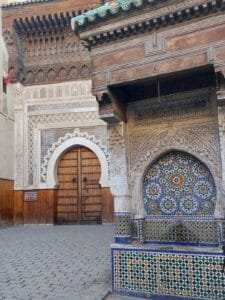
Nestled within a beautifully restored caravanserai, the Nejjarine Museum of Wooden Arts and Crafts offers a serene escape into the world of woodworking, one of the most revered handicrafts in Fez. This remarkable space celebrates the intricate artistry of Moroccan carpentry, where cedarwood takes center stage in an array of stunning carvings and inlays.
The museum’s atmosphere is as rich as its exhibits, with the scent of cedar perfuming the air and sunlight filtering through lattice screens that cast intricate shadows. Among the museum’s treasures are ornately carved doors, lattice panels, and cedar chests inlaid with mother-of-pearl. “Woodworking in Fez is more than a skill—it’s a philosophy,” explains Fatima, a museum guide whose family has been involved in the craft for generations. Each piece on display reflects the harmony between artisan and material, a relationship built on respect and understanding.
Beyond the visual splendor, the museum tells a deeper story of how handicrafts in Fez bridge the past and the present. It’s a place where visitors can reflect on the timelessness of these creations, each one connecting history, nature, and human ingenuity in a profound and beautiful way.
Rue des Mérinides: Exploring Handicrafts in Fez

Rue des Mérinides, often called Artisan Alley, is a sensory wonderland bursting with the vibrant energy of handicrafts in Fez. This lively street, lined with workshops and stalls, is a testament to the city’s enduring artistic legacy. Every step reveals a kaleidoscope of creativity, from richly colored textiles to meticulously painted ceramics and intricate jewelry.
Ceramic artisans, seated at potter’s wheels, mold clay into graceful vases and tiles, their hands moving with practiced precision. The blue-and-white patterns adorning these pieces mirror Fez’s rivers and skies, blending nature with artistic expression. Meanwhile, nearby weavers work tirelessly at their looms, creating vibrant rugs that tell stories of Berber traditions and the rugged beauty of the Atlas Mountains.
“It’s a joy to work with my hands,” says Amina, a weaver who proudly displays her creations. “Every thread I weave carries the essence of my heritage.” This sentiment resonates throughout the alley, where each artisan’s dedication transforms everyday materials into extraordinary works of art. Visiting Rue des Mérinides is not just a shopping experience—it’s an immersion into Fez’s living culture.
Ain Nokbi: Zellige and Pottery Masterpieces in Fez
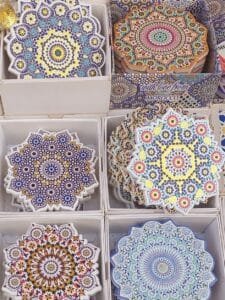
On the outskirts of Fez lies Ain Nokbi, a district renowned for its mastery of zellige tiles and pottery, two quintessential handicrafts in Fez. Here, artisans dedicate themselves to perfecting crafts that combine mathematical precision with artistic flair, producing pieces that are as functional as they are beautiful.
Zellige workshops are mesmerizing to watch, with craftsmen cutting and fitting tiny tiles into intricate geometric patterns. Each arrangement requires absolute precision, as even the smallest misalignment can disrupt the harmony of the design. “It’s like building a mosaic from the soul,” says Ahmed, a tile maker. The completed works, often seen adorning fountains and walls, are masterpieces that showcase Fez’s unrivaled artistry.
In neighboring pottery studios, clay undergoes a magical transformation. Artisans skillfully shape it into bowls, platters, and vases, glazing each piece in vibrant hues before firing them in traditional kilns. The process feels like alchemy, with raw earth becoming timeless objects of beauty. Ain Nokbi’s workshops are a sanctuary of creativity, where visitors can witness firsthand how tradition continues to inspire innovation.
You can support us to enhance how we depict Moroccan artisans and their unique crafts!


